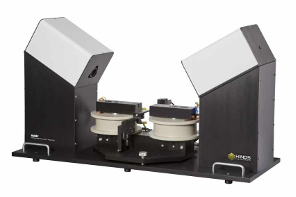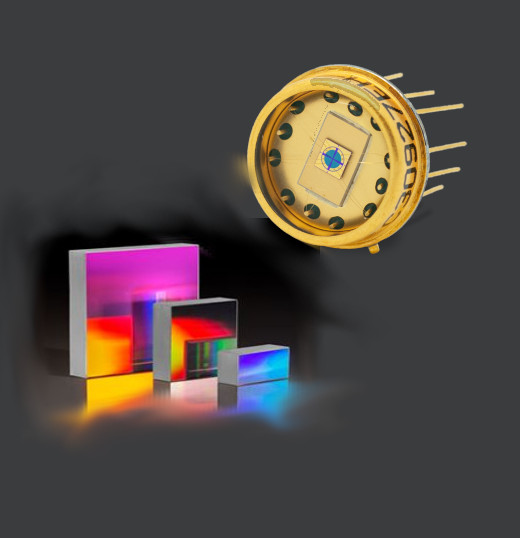MOKE

Oferujemy gotowe systemy jak i komponenty
Magnetooptyczny efekt Kerra (MOKE)

Modulatory fotoelastyczne oferują bardzo czułą metodę generowania stanów polaryzacji do pomiarów magnetooptycznego efektu Kerra (MOKE) w widmach DUV, widzialnym i IR. PEM można również bardzo skutecznie wykorzystać do analizy stanów polaryzacji światła po jego odbiciu od próbki. Prawidłowy dobór detektorów, polaryzatorów, opcji PEM i demodulatorów ma kluczowe znaczenie dla wykrycia niewielkich zmian polaryzacji, które mogą wystąpić.
Photoelastic Modulators offer a highly sensitive method for generating polarization states for Magneto-Optical Kerr Effect (MOKE) measurements in the DUV, visible, and IR spectrums. PEMs can also be used very effectively to analyze the polarization states of light after it has reflected off of the sample. The correct selection of detectors, polarizers, PEM options, and demodulators is critical to detecting the small levels of polarization change that can occur. Hinds Instruments can help you assemble the necessary research grade equipment that will optimize your results.
MOKE Solution Packages can include:
• PEM
• Photodiode or APD Detector
• Laser or other light source
• Lock-in Amplifier or Waveform capture card demodulation
• Polarizers and mounts
• Anti-reflection coatings
Hinds Instruments’ new Magneto Optic Kerr Effect (MOKE) Loop Tracer has application in the rapid generation of hysteresis loops for the characterization of thin film magnetic materials. Using Hinds’ Photoelastic Modulator (PEM) technology, the system provides unrivaled research grade sensitivity.
“The beauty of the photoelastic modulation technique is that, not only does this increase signal-to-noise ratio for the detection of very small magneto-optical effects and can, in some instances, eliminate defects in polarizing devices but the detection of both fundamental and second harmonic signals that are generated are directly proportional to the Kerr (or Faraday) ellipticity and rotation, respectively. This means that these two extremely important parameters can be measured simultaneously.”
- Dr. Ron Atkinson, Professor Emeritus, The Queen’s University Belfast
Features:
• Highest available sensitivity
• Simultaneous measurement of Kerr ellipticity and Kerr rotation
• High repeatability
• High speed hysteresis loop generation provides rapid feedback on process variables
• Non-destructive
• No moving parts in the optical or magnet system
• Simple set-up allows immediate collection of research-grade data
• Hysteresis loop software included with intuitive UI, loop graphing and automated process control
• Sample alignment platform with tilt and height adjustment
• Accommodates 30 mm X 30 mm sample
MOKE
Magneto Optic Kerr Effect (MOKE) experiments are designed to detect small changes in polarization that occur because magnetic fields influence the polarization state of optical radiation as it passes through a transparent medium.
PEM Setting: quarter-wave retardation (λ/4)
Polarization Modulation: right and left circular polarized light
Lock-in reference: PEM's 1st Harmonic
The modulated light is reflected by the sample, which is situated in the center of the electromagnet poles. Setting the analyzer angle to 0° greatly simplifies the mathematical relationship between the intensity ratios measured and the magneto-optical parameters. The following equation represents the resulting signal intensity. From the lock-in values the MOKE parameters θk and εk may be calculated.
Where:
V1f and V2f are the voltages of the first harmonic signals from the lock-in
VDC is the DC signal
J1 and J2 are Bessel function coefficients
The derivation of these equations may be found in the Magneto-Optic Kerr Effect Application Note.
APPLICATIONS
- Data Storage
- Disk Recording Systems
- Dynamic Studies of Film Growth
TYPICAL HEAD ASSEMBLIES
I/FS50 with ARC
Magnetic Field Compatibility Option (MFC)
FURTHER READING
R. Atkinson, "Dynamic in situ optical and magneto-optical monitoring of the growth of Co/Au multilayers", J. Phys.: Condens. Matter. 12, 7735-7745 (2000).
Bennemann K.H., (Ed), Nonlinear Optics in Metals, Clarendon Press, Oxford, (1998).
R. Atkinson, G. Didrichsen, W.R. Hendren, I.W. Salter and R.J. Pollard, "Dynamic in situ optical and magneto-optical monitoring of the growth of Co-Pd multilayers" J. Phys.: Condens. Matter. 13, 691-705 (2001).
Magneto-Optic Kerr Effect
Magnetism in a New Light
Masz pytania ?
Dostawcy








